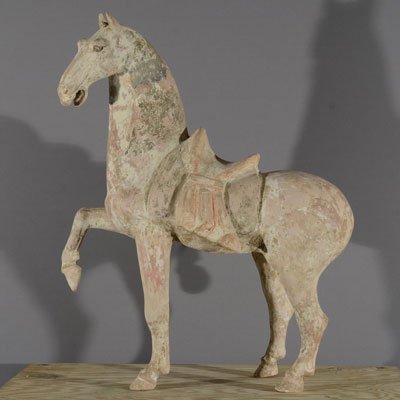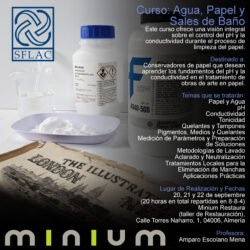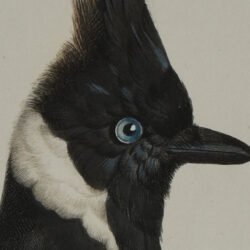Tang horses were made in China as tomb accessories for the comfort and use of the deceased in the afterlife. They were a symbol of status, and are usually found in the tombs of the rich and powerful, as well as the imperial family.
The terracotta horses tradition started in the Qin dynasty (210 B.C), when a new rule abolished the necessity of burying their favorite steeds (or wives) in the tombs with the deceased. From that time on, all kind of pottery objects and artifacts were made to adorn and suffice the necessities of the dead and buried. Among these objects, the potters made all kind of figures, from tomb attendants to aristocratic ladies (the as well famous “Fat Ladies”), farm animals, vessels, soldiers, etc, but without any doubt, the ones that have gathered all the fame are the Tang Horses.
Horses were, at the moment, a representation of strength, speed and endurance and that is why the potters were captivated by them and hence the effort and pride they put into making the best models. The best Tang horses are very well animated, with a strong face, the mouth open and a powerful musculature.
[/mp_text] [/mp_span_inner] [mp_span_inner col="8"] [mp_image id="3576" size="full" link_type="lightbox" link="#" target="false" caption="true" align="left"] [/mp_span_inner] [/mp_row_inner] [/mp_span] [/mp_row] [mp_row] [mp_span col="6"] [mp_image id="3577" size="full" link_type="lightbox" link="#" target="false" caption="true" align="left"] [/mp_span] [mp_span col="6"] [mp_text]Tang sculptors/potters reached a high level of expertise in molding techniques. Tang horses were made with several molds. The molds were deeply hollowed and the overall result was very voluminous. The molds were used over and over again and once the different parts of the horse were joint together, all the details were manually added to differentiate one from the other, giving each one of them a certain individualism.
In relation to the surface finishes, they varied between glazed or painted. Rich glazes were usually tricolor and they were even better if they had touches of cobalt blue (that at that moment was more expensive than gold). Good potters use to apply them allowing them to run from the top of the horse to the bottom in a controlled manner, so that it stopped just on the hooves. But it is in the painted ones were the potters unfold their artistic side with the application of fine details, with an overall decoration that fascinated the tang aristocracy then, and the avid collector now.
[/mp_text] [/mp_span] [/mp_row] [mp_row] [mp_span col="12"] [mp_text]Conservation Treatment
Recently, we have had the opportunity to work on a magnificent Tang Horse. It was brought to us with a broken leg and the corner of the saddle cloth broken as well. The different parts were joined with an appropiate adhesive. Usually these kinds of breakages are not clean and a lot of original material is lost due to the pulverization of the terracotta in the areas adjacent to the breakage. For that reason, a filler was needed to level the surface in the broken area and prepare it for inpainting. The inpainting was performed binding raw pigments together with a cellulose ether characterized for its long term stability. We also added an inert compound to match the characteristic granulometry of the surrounding surfaces.
[/mp_text] [/mp_span] [/mp_row] [mp_row] [mp_span col="12"] [mp_grid_gallery ids="3578,3579,3580" columns="3" size="medium" link_type="lightbox" target="false" caption="true"] [/mp_span] [/mp_row] [mp_row] [mp_span col="12"] [mp_text]Once the treatment was finished, we were able to contemplate the beauty of the tang horse our client brought to us. It was a prancing, painted horse that stands with the right leg lifted. It is realistically modeled, with well defined face and legs. The head is somewhat turned to the left, with the mouth slightly open, and well defined pricked ears. The arched neck is carved with a groove that use to hold a real mane made out of horsehair. On the back there is also a hole for a real tail. The saddle appears covered with a cloth that is beautifully gathered in folds, and the surface has traces of the original pigmentation. This horse, with its beautiful stance, exquisite modeling and the real mane and tail probably belonged to the entombment of a high official.
[/mp_text] [/mp_span] [/mp_row]





4 Responses